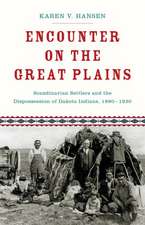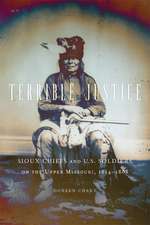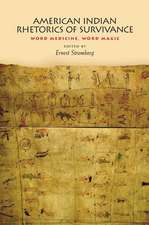Re-Collecting Black Hawk: Landscape, Memory, and Power in the American Midwest
Autor Nicholas A. Brown, Sarah E. Kanouseen Limba Engleză Hardback – 22 mai 2015
The name Black Hawk permeates the built environment in the upper midwestern United States. It has been appropriated for everything from fitness clubs to used car dealerships. Makataimeshekiakiak, the Sauk Indian war leader whose name loosely translates to “Black Hawk,” surrendered in 1832 after hundreds of his fellow tribal members were slaughtered at the Bad Axe Massacre.
Re-Collecting Black Hawk examines the phenomena of this appropriation in the physical landscape, and the deeply rooted sentiments it evokes among Native Americans and descendants of European settlers. Nearly 170 original photographs are presented and juxtaposed with texts that reveal and complicate the significance of the imagery. Contributors include tribal officials, scholars, activists, and others including George Thurman, the principal chief of the Sac and Fox Nation and a direct descendant of Black Hawk. These image-text encounters offer visions of both the past and present and the shaping of memory through landscapes that reach beyond their material presence into spaces of cultural and political power. As we witness, the evocation of Black Hawk serves as a painful reminder, a forced deference, and a veiled attempt to wipe away the guilt of past atrocities. Re-Collecting Black Hawk also points toward the future. By simultaneously unsettling and reconstructing the midwestern landscape, it envisions new modes of peaceful and just coexistence and suggests alternative ways of inhabiting the landscape.
Re-Collecting Black Hawk examines the phenomena of this appropriation in the physical landscape, and the deeply rooted sentiments it evokes among Native Americans and descendants of European settlers. Nearly 170 original photographs are presented and juxtaposed with texts that reveal and complicate the significance of the imagery. Contributors include tribal officials, scholars, activists, and others including George Thurman, the principal chief of the Sac and Fox Nation and a direct descendant of Black Hawk. These image-text encounters offer visions of both the past and present and the shaping of memory through landscapes that reach beyond their material presence into spaces of cultural and political power. As we witness, the evocation of Black Hawk serves as a painful reminder, a forced deference, and a veiled attempt to wipe away the guilt of past atrocities. Re-Collecting Black Hawk also points toward the future. By simultaneously unsettling and reconstructing the midwestern landscape, it envisions new modes of peaceful and just coexistence and suggests alternative ways of inhabiting the landscape.
Preț: 327.52 lei
Nou
Puncte Express: 491
Preț estimativ în valută:
62.68€ • 65.27$ • 52.97£
62.68€ • 65.27$ • 52.97£
Carte disponibilă
Livrare economică 17 februarie-03 martie
Preluare comenzi: 021 569.72.76
Specificații
ISBN-13: 9780822944379
ISBN-10: 0822944375
Pagini: 294
Ilustrații: 167
Dimensiuni: 178 x 254 x 25 mm
Greutate: 0.91 kg
Ediția:1
Editura: University of Pittsburgh Press
Colecția University of Pittsburgh Press
ISBN-10: 0822944375
Pagini: 294
Ilustrații: 167
Dimensiuni: 178 x 254 x 25 mm
Greutate: 0.91 kg
Ediția:1
Editura: University of Pittsburgh Press
Colecția University of Pittsburgh Press
Recenzii
"Re-Collecting Black Hawk puts forth a provocative and thorough examination of how a historical Sac and Fox leader has been reduced to a footnote. . . . Brown and Kanouse are adept at pairing their selected photos and text. The result is a window into how Sac and Fox people view the co-opting of the name and life of one of their ancestral leaders . . . As an educational tool, Re-Collecting Black Hawk could make a formidable text for US history studies at the university level, particularly in discussions of how the dominant European culture of the US has all but buried the existence of peoples who were on the North American continent before Europeans arrived. Its other, equally vital use (if not more so to the Sac and Fox people) is in gathering up information about the actual Black Hawk and returning it to its real-life context. It’s a laudable effort that succeeds very well."
—Foreword Reviews
—Foreword Reviews
"Re-Collecting Black Hawk is a demonstration of the potential for innovation in the field of history. The example set by the editors should be embraced by other historians, popular and academic, in their pursuit to convey relevance and foster a spirit of revisionism. . . . Brown and Kanouse have drawn on their academic training in art and history to produce a work that is at once both artistic commentary and historical scholarship. [This book] contributes to the historiography through its choice of subject matter and the way that information is conveyed. [The editors] have utilized their unique combination of skills to challenge the assumptions held by Americans of non-indigenous descent."
—H-Net Reviews
—H-Net Reviews
“In this extraordinary collection of essays and images, the authors ask challenging questions about regional identity, national history, and the place of Native peoples in contemporary culture. . . .In the process, Brown and Kanouse raise deep and disturbing questions about the foundations of the U.S. . . . Throughout, the authors provide an approachable account of settler colonialism and meaninfgul pathways to engage it.”
—Choice
—Choice
“The decade’s smartest and most destabilizing book on Indians, Americans, amnesia, and memory. This book unsettles conventional wisdom of all kinds. Straightforward images document the massive and mysterious project by citizens of Iowa, Wisconsin, and Illinois to inscribe the name of a nineteenth century Indian leader on a staggering variety of stores, parks, bars, nursing homes, teams, and schools. An instant classic, in the tradition of Michael Lesy’s Wisconsin Death Trip.”
—Paul Chaat Smith, author of Everything You Know about Indians Is Wrong
—Paul Chaat Smith, author of Everything You Know about Indians Is Wrong
“An artistic work, yet much more than a coffee table book for casual readers. . . [it is] a work that anyone interested in Native American history and politics should read.”
—Journal of the Iowa Archeological Society
—Journal of the Iowa Archeological Society
“Re-Collecting Black Hawk is an important and exciting work of cultural geography and Native studies. Featuring a fascinating photo-essay and foregrounding the voices of tribal administrators, Native scholars and artists, this innovative book will be accessible and valuable to a diverse range of readers interested in memory and landscape in the American Midwest.”
—Bill Anthes, Pitzer College, The Claremont Colleges
—Bill Anthes, Pitzer College, The Claremont Colleges
"The design of the book, its subject and methodology, gracefully and forcefully demonstrate how the study of place names might be done."
—Journal of Onomastics
—Journal of Onomastics
Notă biografică
Nicholas A. Brown is a visiting assistant professor in the American Indian and Native Studies program at the University of Iowa.
Sarah E. Kanouse is an associate professor in the School of Art and Art history at the University of Iowa.
Sarah E. Kanouse is an associate professor in the School of Art and Art history at the University of Iowa.


















